
Royal Liverpool Philharmonic is a music organisation based in Liverpool, England, that manages a professional symphony orchestra, a concert venue, and extensive programmes of learning through music. Its orchestra, the Royal Liverpool Philharmonic Orchestra, is the UK's oldest continuing professional symphony orchestra. In addition to the orchestra, the organisation administers the Royal Liverpool Philharmonic Choir, the Liverpool Philharmonic Youth Company and other choirs and ensembles. It is involved in educational and community projects in Liverpool and its surrounding region. It is based in the Liverpool Philharmonic Hall, an Art Deco concert hall built in the late 1930s.
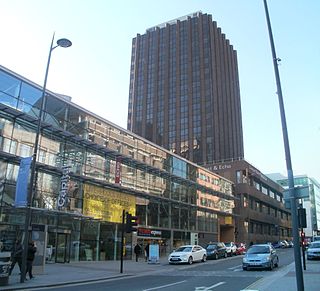
The Liverpool Echo is a newspaper published by Trinity Mirror North West & North Wales – a subsidiary company of Reach plc and is based in St. Paul's Square, Liverpool, Merseyside, England. It is published Monday through Sunday, and is Liverpool's daily newspaper. Until January 13, 2012, it had a sister morning paper, the Liverpool Daily Post. Between July and December 2022, it had an average daily circulation of 15,395.

Liverpool Philharmonic Hall is a concert hall in Hope Street, in Liverpool, England. It is the home of the Royal Liverpool Philharmonic Society and is recorded in the National Heritage List for England as a designated Grade II* listed building. It is not the original concert hall on the present site; its predecessor was destroyed by fire in 1933 and the present hall was opened in 1939.
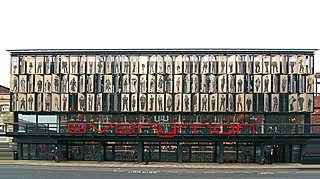
The Everyman Theatre stands at the north end of Hope Street in Liverpool, Merseyside, England. It was founded in 1964, in Hope Hall, in an area of Liverpool noted for its bohemian environment and political edge, and quickly built a reputation for ground-breaking work. The Everyman was completely rebuilt between 2011 and 2014.

The Philharmonic Dining Rooms is a public house at the corner of Hope Street and Hardman Street in Liverpool, Merseyside, England, and stands diagonally opposite the Liverpool Philharmonic Hall. It is commonly known as The Phil. It is recorded in the National Heritage List for England as a designated Grade I listed building.

Cains was a brewery in Liverpool, England, founded in 1858 by Robert Cain. The company merged with Peter Walker & Son in 1921 to form Walker Cains. Peter Walker & Son had a large brewery in Warrington so sold its Liverpool brewery to Higsons in 1923. Boddingtons of Manchester took over in 1985. In 1990, Whitbread acquired Boddington's brewing operations and closed the brewery. It was reopened by GB Breweries, who became part of Bryggerigruppen in 1991, and in 2002 was sold to Gardener-Shaw for £3.4 million.

Hope Street in Liverpool, England, stretches from the city's Roman Catholic cathedral, past the Anglican cathedral to Upper Parliament Street and it is the local high street of the Canning Georgian Quarter. It contains various restaurants, hotels and bars and is one of Liverpool's official 'Great Streets' and was also awarded 'The Great Street Award' in the 2012 Urbanism Awards, judging it to be the best street in the country. The road runs parallel to Rodney Street. Together with Gambier Terrace and Rodney Street it forms the Rodney Street conservation area.

Central was an electoral division of Liverpool City Council in the Liverpool Riverside Parliamentary constituency.
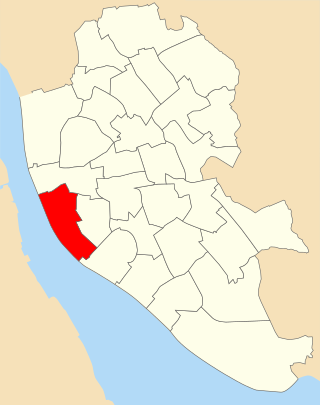
Riverside ward was an electoral division of Liverpool City Council covering the southern city centre, the Dingle, and parts of Toxteth.
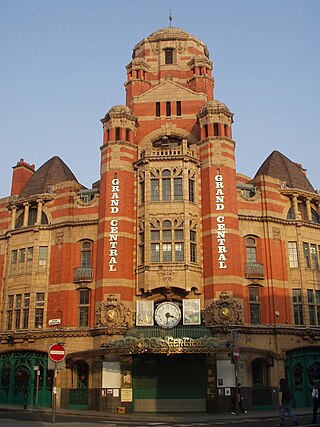
The Grand Central Hall is on 35 Renshaw Street, Liverpool, England. It is now the site of the Liverpool Grand Central Hotel, Hall and Grand Bazaar Food Hall. The building is recorded in the National Heritage List for England as a designated Grade II listed building.

Korova was a bar, music venue and restaurant located at 32 Hope Street, Liverpool, England. Before moving to its current premises, it was located on Fleet Street close to Concert Square. Its name referenced the Korova Milk Bar from A Clockwork Orange.. It has since been relaunched as "Frederick's".
The Hope Street Hotel on Hope Street, Liverpool, describes itself as 'Liverpool's first boutique hotel'. On 30 and 31 March 2006 it played host to Condoleezza Rice. The hotel is housed in an 1860 Venetian-style palazzo, originally home to and named 'The London Carriage Works', which is how the hotel's restaurant came to be named.

Stanley Street, in the centre of Liverpool, England, runs south between Dale Street and Whitechapel. As well as being home to numerous businesses ranging from estate agents, solicitors, bars and restaurants, there are also apartments in upper floors of some of the buildings. As part of the Big Dig, the southern half of the street between Whitechapel and Victoria Street was repaved in 2007, and is used as a taxi-rank serving Liverpool's central shopping district and Mathew Street.
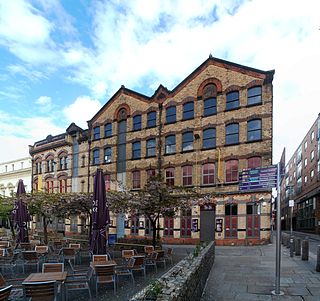
Concert Square is a square located between Wood Street and Fleet Street in the RopeWalks area of Liverpool City Centre, England. The square and the immediate surrounding area is often referred to as the heart of Liverpool's nightlife, due to the area being populated with some of the best known nightclubs and bars in the city, and indeed the North West of England. The square has often been a centre for football fans' celebration. A 2019 survey of university students in the UK found two Liverpool universities ranked amongst the top 5 for nightlife, with Concert Square being cited as a factor.

Liverpool city centre is the commercial, cultural, financial and historical centre of Liverpool and the Liverpool City Region, England. Different definitions of the city centre exist for urban planning and local government, however, the border of Liverpool city centre is broadly marked by the inner city districts of Vauxhall, Everton, Edge Hill, Kensington and Toxteth.
Radio City is an Independent Local Radio station based in Liverpool, England, owned and operated by Bauer as part of the Hits Radio network. It broadcasts to Merseyside, Cheshire and parts of north Wales.

The Royal School for the Blind in Liverpool, England, is the oldest specialist school of its kind in the UK, having been founded in 1791. Only the Institut National des Jeunes Aveugles in Paris is older, but the Royal School for the Blind is the oldest school in the world in continuous operation, and the first in the world founded by a blind person, Edward Rushton, who was also an anti-slavery campaigner. It was also the first school in the world to offer education and training to blind adults as well as children.
Hope Street Chapel was a Unitarian place of worship in Liverpool, England. It stood on Hope Street next to the Philharmonic Hall, Liverpool, about halfway between the Anglican and Catholic Cathedrals. The congregation had previously been based in Paradise Street and before that in Kaye Street. The church was opened in 1849, and demolished in 1962.

Penny Lane is a street situated south off the A562 road in the Mossley Hill suburb of Liverpool, England. The name also applies to the area surrounding the thoroughfare. During the 20th century, it was the location for one of the main bus terminals in Liverpool, and gained international notability in 1967 when the Beatles released their song "Penny Lane" in tribute to their upbringing in Liverpool.

Liverpool College of Music was an academy for classical musicians that existed between around 1884 and 1911, originally at 11 Hardman Street. The building was first known as the Meyerbeer Hall and was opened on 31 December 1867. It was also used by Liverpool Spiritualist Church from 4 June 1876 to 1885 before becoming the College. By 2020 the building had become the 'Hard Wok Café'.
















